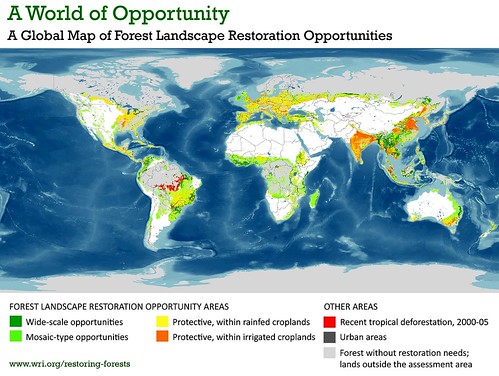FORESTS FOREVER

via World Resources Institute
This map shows a world of opportunity for restoration of forest landscapes.
Stopping additional deforestation and degradation is a critical part of global efforts to fight climate change. Much of the conversation is focused on countries where forests are disappearing at a rapid rate, such as Brazil and Indonesia.
- Download High Resolution Bitmap (PNG, 5052 x 2472 px, 5.7 Mb)
- Download Brochure (PDF, 4 pages, 5.1 Mb) (includes map)
- View previous version of this map
But recent research suggests huge opportunities for restoration of forest landscapes as well. The Global Partnership on Forest Landscape Restoration (GPFLR) with WRI, South Dakota State University, and IUCN have produced an updated map showing where global forests have great potential for recovery. While many maps show forest loss, this one is the first of its kind to show areas where forests could be regained. This has significant implications for climate negotiators that are working to reduce and reverse carbon emissions from forests.
The Potential for Forest Restoration
The forest landscape restoration opportunity map does not indicate the location of individual restoration sites, only wider landscapes where restoration opportunities are more likely to be found. Nor does it indicate or prescribe any particular type of restoration intervention (e.g. spontaneous regrowth or planting). Its goal is to show lands with characteristics that indicate restoration opportunities.
The map shows that restoration opportunities are prominent on all continents. Many countries, not least in Africa, that have had their forests exposed to deforestation and degradation long ago will find rich opportunities to contribute to REDD-plus through forest landscape restoration.
An estimated billion and a half hectares of deforested and degraded forest land offer opportunities for forest landscape restoration, either wide-scale or mosaic type (an area almost equivalent to Russia). About two thirds of the potential is on deforested lands; the rest is in degraded forests and woodlands.
Additional restoration opportunities -— mainly for protective purposes – are scattered within the world’s croplands.
The restoration opportunities are typically not located in areas of ongoing deforestation and degradation; they tend to occur where degradation and deforestation have already made their mark.
These areas should not all be restored in the same fashion. There is no one-size-fits-all solution. Each forest landscape is unique and needs its own restoration design which responds in a balanced way to societal preferences and needs. Lands that are currently used for crop production or grazing, for example, are not suitable for wide-scale restoration. They may, however, offer opportunities for restoration in mixed land-use mosaics. Many historically deforested areas belong to this category.
Co-Benefits of Forest Restoration
One of the most attractive features of this approach to restoration is its many co-benefits. The Convention on Biological Diversity at its recent meeting in Nagoya (October 2010) agreed on a target to restore 15 percent of degraded ecosystems by 2020. Properly implemented REDD-plus initiatives could bring benefits for biodiversity and climate while also improving livelihoods and food security.
The Global Partnership on Forest Landscape Restoration
The Global Partnership on Forest Landscape Restoration (GPFLR) is a worldwide network that unites influential governments, major UN and non-governmental organizations, companies and individuals with a common cause. We believe that ideas transform landscapes. The partnership provides the information and tools to strengthen restoration efforts around the world and builds support for forest landscape restoration (FLR) with decision-makers and opinion-formers, both at local and international level.
This preliminary map was prepared for the GPFLR by the World Resources Institute, South Dakota State University and IUCN, and is the starting point for a global assessment of restoration potential.
Authors
- Peter Potapov, South Dakota State University
- Lars Laestadius, World Resources Institute
- Susan Minnemeyer, World Resources Institute
- Carole Saint-Laurent, Global Partnership on Forest Landscape Protection
For More Information, Contact:
The map has been produced with support from PROFOR and the Forestry Commission of Great Britain for the GPFLR by the World Resources Institute (WRI), South Dakota State University (SDSU) and the International Union for Conservation of Nature (IUCN). The opinions expressed in this publication do not necessarily reflect those of these organizations.
- Lars Laestadius, Ph.D.
Senior Associate, World Resources Institute- Carole Saint-Laurent, LL.M.
Coordinator, Global Partnership on Forest Landscape Restoration
Senior Adviser, Forest Policy and Partnerships, IUCN






No comments:
Post a Comment